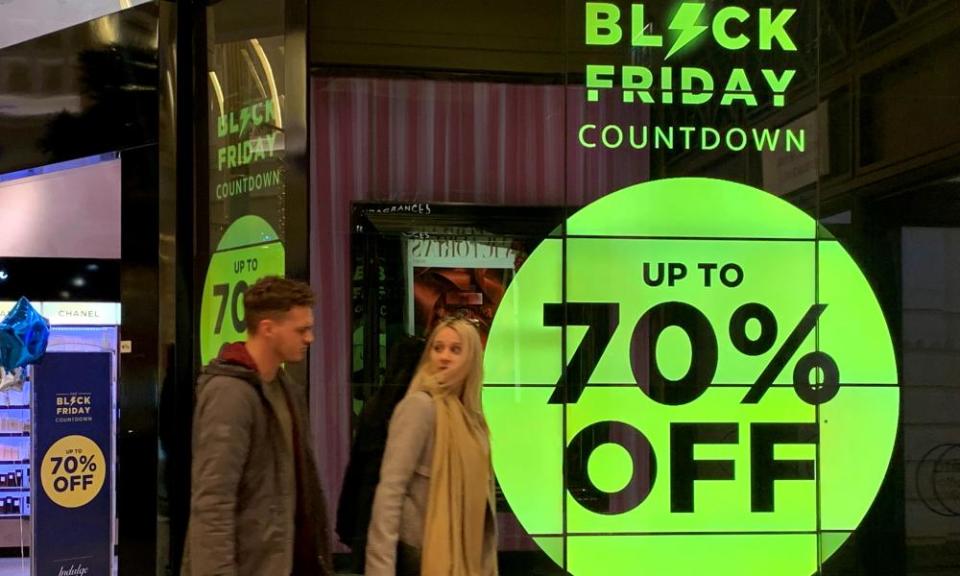UK retailers enjoyed 'outstanding' Black Friday sales figures

Forecasts that Black Friday would leave shopping centres deserted as consumers shopped online or boycotted fake bargains have been confounded by figures revealing a sharp rise in sales.
Barclaycard, which processes about £1 of every £3 spent in the UK, said it was an “outstanding” Black Friday compared with last year.
It said transaction value was up 16.5% compared with last year, with the volume of transactions up 7.2%. “Once again Black Friday has continued to be a fantastic opportunity for retailers and consumers,” it said.
It added that Cyber Monday had also got off to a strong start, with transaction volume up by 6.9% compared with 2018.
Even the ailing high street experienced a jump in sales. According to retail data company Springboard, footfall – a gauge of shop visits – was up 3.3% on Black Friday in comparison with the same day in 2018. Shopping centres fared best, with visitor numbers up 6.5%.
Behind the soaring sales lay an important fact – that as Black Friday fell on the 29th of the month, it also coincided with the monthly payday for millions of workers.
Springboard tracked numbers through the day, and said increased footfall was strongest at about 5pm, suggesting that many people joined the annual shopping frenzy as offices shut.
The figures suggest that reports of Black Friday fatigue among shoppers, deterred by bogus discounting, may have been wide of the mark. They will also fuel a determination among retailers to keep Black Friday as a key retail event in the run-up to Christmas.
Diane Wehrle, Springboard’s insights director, said: “This positive result may well seal the deal for retailers in terms of their commitment to Black Friday moving forward, as they will have claimed shoppers early on in the Christmas trading period giving them the opportunity to steal a march on their rivals.”
But there is mounting evidence that the Black Friday sales simply displace spending that might otherwise have taken place in early December.
Springboard said it was anticipating a lull in sales before a last-minute rush before Christmas, with Saturday 21 December expected to be the busiest sales day of the year.
Since 2011, shortly after Amazon first introduced the Black Friday concept to UK shoppers, high street footfall for the month of December has dropped year-on-year. Last year it fell by 2.6% compared with the previous December, and this year is expected to contract again, by about 1.5%.
Springboard tracks shopper numbers at 450 different retail locations across the UK, and its figures also provide an insight into how consumer behaviour has changed in the post-Christmas sales.
It said: “Post-Christmas it is expected that footfall on 27, 28 and 29 December will be higher than on Boxing Day, which historically was the key sales day. In 2018, footfall on each of these three days was a third higher than on Boxing Day as many consumers now initially search for bargains online before venturing to the stores themselves.”
Meanwhile, the British Retail Consortium said on Tuesday that the outlook for its members had been improving in the weeks leading up to Black Friday.
After making adjustments to account for the bargain day coming later than in 2018, the BRC said sales were higher in November 2019 than a year earlier – a stronger performance than in recent months.
Like for like sales – which take into account increased floorspace – were 0.4% higher than a year ago.
Helen Dickinson, the BRC’s chief executive, said: “Once the figures are adjusted to take account of the timing of Black Friday, growth appears stronger in November than in previous months. Shoppers appeared ready to take advantage of the great bargains available, both online and on the high street.
“Electronics and clothes both benefited from big discounts, with the recent cold snap adding further urgency to purchases of winter-wear. Furthermore, as the spectre of a no-deal Brexit has been pushed back to after Christmas, consumers were more prepared to open their wallets to a little extra festive spending.”

 Yahoo Finance
Yahoo Finance 